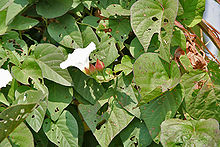- Operculina turpethum
-
Operculina turpethum 
in Kawal Wildlife Sanctuary, India. Scientific classification Kingdom: Plantae (unranked): Angiosperms (unranked): Eudicots (unranked): Asterids Order: Solanales Family: Convolvulaceae Genus: Operculina Species: O. turpethum Binomial name Operculina turpethum
(L.) Silva MansoSynonyms Merremia turpethum (L.) Shah & Bhatt.[1]
A plant in the morning glory family, Operculina turpethum (syn. Ipomoea turpethum) is known commonly as turpeth, fue vao, and St. Thomas lidpod.
It is perennial herbaceous, hairy vines growing 4 to 5 meter in length, endemic to India. It is commonly found in North Circars and Deccan region up to 3000 ft. The leaves are alternate, very variable in shape, ovate, oblong and truncate or cordate at the base. The flowers are large, axillary and solitary. Fruit is a capsule with conspicuous enlarged sepals and thickened pedicles.
It is commonly known as[2]: Indian Jalap, St. Thomas lidpod, transparent wood rose, turpeth root, white day glory • Hindi: निशोथ nisoth, पिठोरी pitohri • Kannada: aluthi gida, bangada balli, bilitigade, devadanti, nagadanti • Malayalam: tigade • Marathi: निसोत्तर or निशोत्तर nisottar • Sanskrit: निशोत्र nishotra, त्रिपुट triputa, त्रिवृथ trivrutha • Tamil: adimbu, சரளம் caralam, சிவதை civatai, கும்பஞ்சான் kumpncan, பகன்றை paganrai • Telugu: తెగడ tegada, త్రివృత్ తెల్లతెగ trivrut tellatega
Contents
Uses
It contains glucoside Turpethin and resin similar to Jalap resin. It is used as an herbal purgative and prescribed in Scorpion and Snake bites.
References
External links
 Media related to Operculina turpethum at Wikimedia Commons
Media related to Operculina turpethum at Wikimedia Commons- USDA Plants Profile
- Caldecott, Todd (2006). Ayurveda: The Divine Science of Life. Elsevier/Mosby. ISBN 0723434107. Contains a detailed monograph on Operculina turpethum (Trivrit), as well as a discussion of health benefits and usage in clinical practice. Available online at http://www.toddcaldecott.com/index.php/herbs/learning-herbs/337-trivrit
Gallery
Categories:
Wikimedia Foundation. 2010.

